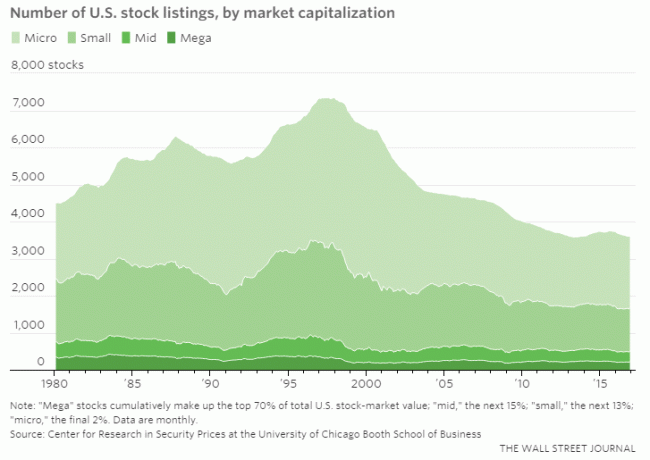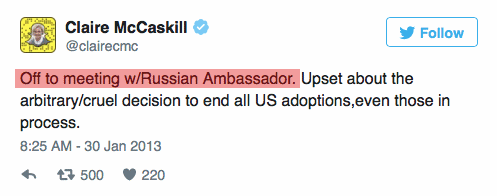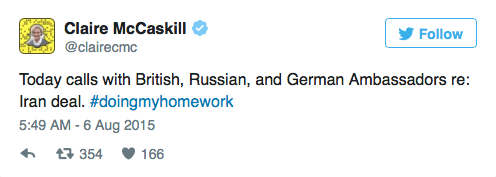In my previous post here I explained why the Google memo is fundamentally right in its factual claims about the broad population, which in turn explains the proportion of women in Google itself. Here I discuss some arguments against what has already been explained.
The first argument is the
Argument ad Asia

The argument here is that there are many countries where women are the majority among students in science. Most of these countries are not what one could call gender egalitarian. As I explained in the previous post, if one’s explanation is that the main driver of unequal outcomes is sexism, one would have to expect that the less sexism the more women in science, but we don’t see that.
Still, one can make another point from this chart: that this proves that culture matters. It is not a genetic given that women have to be 40% or less in STEM.
What is more, one can make a stronger
Argumentum ad India
- In India, for whatever reason, 43% of undergrads in CS are women
- Thus, it is not set in stone that they must be a smaller fraction
- Thus the cause for the differences cannot be genetic in nature
- Then it is environmental, and adequate policies can change it
Or one can go full gung-ho and make the
Argumentum ad Saudi Arabia
- In Saudi Arabia, for whatever reason, 59% of students in CS are women
- Thus, it is not set in stone that they must be a smaller fraction
- Thus the cause for the differences cannot be genetic in nature
- Then it is environmental, and adequate policies can change it
Coming closer home, there is the
Argumentum ad MIT
- MIT has a 46% share of females
- MIT focuses on engineering
- MIT has succeeded in almost equalising the ratios for engineering
- Thus, regardless of other factors, good diversity policies alone can unskew the ratios
Argumentum ad Harvey Mudd
- Harvey Mudd college went from 15% females in CS to 55%
- Harvey Mudd has succeeded in equalising the ratio
- Thus, regardless of other factors, good diversity policies alone can unskew the ratios
Argumentum ad Carnegie Mellon University
- CMU went from 34.3% to 48.5% females in CS
- Harvey Mudd has succeeded in equalising the ratio
- Thus, regardless of other factors, good diversity policies alone can unskew the ratios
Why the arguments ad Asia fail
Is it a Western bias?
One could then claim that perhaps the skew is a western thing. A glance at data from other developed nations like Japan, Korea, Singapore, or Israel confirms that this is not the case:
Korea:

Singapore:

Israel:

There is simply no developed country where the pattern (women tend to cluster in education, humanities, bio, and men in engineering, and IT) does not hold.
So then, what in the fact that countries develop makes it so that less developed countries have more equal ratios? It is highly dubious that it is gender equality itself. India is one of the most sexist countries on Earth:


Saudi Arabia
So then what happens with India or Saudi Arabia? It cannot be that they are more feminist. The reason why that is happening may be of crucial importance. Let us study Saudi Arabia first:

This may suggest an answer: perhaps it’s not that more women choose computer science. What matters for the ratio of both women choosing, and men choosing.
Interestingly, the OECD reports the same number of males and females attending bachelors. What is interesting is that a large fraction of men, instead of pursuing bachelors, pursue what the OECD calls “Short-cycle tertiary education”. The ratio there is 73.4% male, and 30% of the aggregate men who attend either short cycle education or bachelors are in those short cycle courses. The graph above is for bachelor level. If we look at those short courses in science, mathematics, and computing (Which, it has to be remarked, is not just CS), the percentage of females is 24.2%.
We should ask a different question, perhaps: What do women study? The usual:

So there’s a potential explanation: a statistical mismeasure. Unfortunately I couldn’t find much more information.
[Edit. I found some extra information here, some bits below]
Arab women are still more likely to study arts and humanities and less likely to study science and engineering than Arab men.
[…]
Despite the overall steep increase of Arab female education rates, commensurate increases in Arab female employment have yet to materialize (see figure 2). The Arab world is an aberration to economic theories that assume that increased education of women leads to significant change in their employment levels. In fact, Arab women with post-secondary educations are more likely to be unemployed than women who do not have a post-secondary education.
[…]
Arab women’s employment is highly gendered, as women are more likely to work for the public sector, as well as in traditional roles of teaching, administrative and clerical services, and social and welfare services like nursing. In a study on the UAE, researchers found that career choices
were more likely based on societal pressures of what were deemed to be respectable occupations for Emirati women. Here, the public sector was viewed as a respectable work environment with short hours that end early in the day, substantial time off, and oversight by and of fellow nationals. There was greater skepticism and uncertainty about private sector environments with more diverse workforces, longer hours, more work-related travel, and
fewer adherences to conservative customs. As a result of this gendered sorting, the UAE public sector is overwhelmingly female—65 percent of civil servants are women.20
India
Let’s move on to India. In 2012-13, 43% of the total student population were women. Out of the 9.3 million female students, 34.6% are in science and technology fields. Within that, 19.1% are in engineering. You may wonder where do the majority go. Here’s the answer. Note that this is not the fraction of women within field. This is where women decide to go out of the whole female population.

Now, within fields, this is the proportion of women:

But this is odd. If out of the women who go to university, 10% go to engineering school how comes 20% are in engineering? (Maybe the 2000 data has changed substantially?) If we also know that women are 40-46% of the total, this means men are going elsewhere. So we need more information. Like this graph here
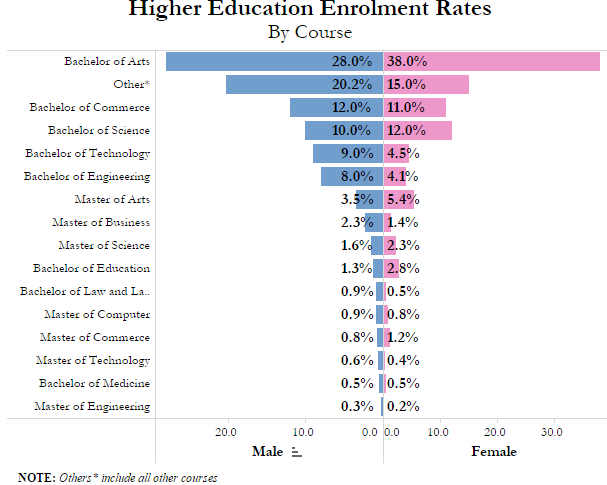
Does the pattern reemerge here? It seems so. If one takes into account that there are 12.4+1.9+0.6=14. million women in uni and 14+1.8+1.6=17.4 million men, then one can calculate the gender ratios by degree and make even more plots. Here at Nintil we love plots.

And by field:

So our answer to where men are going is to “Other”. That category is absorbing 20.2% of all males. But if we look at bachelors and masters of technology, the pattern comes back. For some reason nursing is absent from the data above, but the data is available here: the percentage of women is 81%. For bachelor of computer applications, also absent from the above, 43% are women.
If we further zoom into and peruse engineering data for undergraduates, we finally find a key reason:

Basically, while within engineering the proportions of women in what we might assimilate to CS is higher than in the west, women are MASSIVELY underrepresented in mechanical engineering, which is the biggest branch of engineering in India.
So this is a key part to solution to the apparent discordance with the international pattern: In the aggregate, women are still preferring “people-subjects” and men are preferring “things-subjects”, but WITHIN things-subjects, preferences are different compared to the West. We might ask this question: Out of the entire set of women who study at university, how many are in computer science in India? And the answer is 3.4%. . If we ask the same question for the United States, from here we get 5450 female CS ungraduates. From here we get 14 million female undegraduates. A simple division gives us how many female students pick CS. And the answer is 3.9%.
India (II)
I made mistakes in my previous paragraph. I wasn’t careful in picking sources, and I wasn’t careful doing simple math. Turns out I had also chosen total female enrolled population, not number of graduates. I sometimes make mistakes. But I won’t let them uncorrected.
There were 1914 female bachelor graduates in CS (data from 2013-14). And according to the same data, there were 11306 males. That means that 46% of CS graduates were female. This is odd, given the gap everyone else reports in the US. The gap here is 14%. If we instead consider all the category of “Computer and information sciences and support services”, we get a gap of 18%. In total, 1.068 million females graduated. If we take computer science narrowly defined, 0.18% of women picked it. If we take computer science broadly defined (including the support services bit), the figure is 0.93%.
Now, for India, we have to go to table 35 of the document linked above, we can get the figures for a variety of categories that sound computer sciencey-. The denominator in this case is 3.2 million women
- IT & Computer: 2.64% (84660 female students)
- Computer Engineering: 2.47% (79236 female students)
- Information Technology: 0.81% (26143 female students)
For completion let’s look at postgraduates too, as for the Indian data there is no item called CS except for postgraduate studies.
- 11948 female students completed postgraduate students vs 6231 male ones in CS. Thus there are 65% women in CS Masters. In the degrees cited above, the ratio was more equal.
- Out of the 739150 female students who got a postgrad in India, 11948 picked CS. This means 1.61%.
This it is not a naming conventions issue: contrary to my expectations, women do choose studies in computer science in India in a greater proportion than in the US.
Why? One hypothesis is of course sexism, or perceptions of CS being a male industry in the US, vs being perceived as being perceived as neutral. Testing the sexism hypothesis is difficult. (How would you do it?)
Another hypothesis is that male-female preferences in things vs people oriented tend to be similar, but that, as I mentioned earlier, the distribution is different within those fields, perhaps due to different earnings, or perhaps, yes, because of relative sexism. In other words: Is this higher choice of CS because women choose other STEM subjects less, or because they choose fields like education, nursing, or psychology less? The relative sexism hypothesis, that CS is less sexist, than, say mechanical engineering in India, would predict that CS is chosen more, mechanical engineering is chosen less, and also that on the aggregate, that women would choose more CS. We have confirmed that women do in fact choose more CS.
Do men choose CS less? In the US, 1.41% of all men chose CS narrowly defined, and 5.66% broadly defined. In India, it was 3.38% for the broadly defined measure. For the narrow measure we have to compare MScs: 0.93% for India and 1.7% for the US. Thus men also choose less CS in India too. Now that we are at it, we can get the numbers for mechanical engineering: 2.65% (US) and 5.1% (India). Almost twice as many in India!
Do women choose less mechanical engineering? In the US, 0.30% of all women chose mechanical engineering, while in India it was 0.284%, similar enough.
To recap until now this dance of numbers:
- Women pick CS more than in the US
- Women pick mechanical engineering at equal rates vs the US
- Men pick CS less than in the US
If we aggregate the US and India data and create STEM (Science, Engineering, and IT&Compute in India and Engineering, math/stats, physical sciences, biosciences, and computational science) and Education and health professions on the other side, we get that:
- In the US, 57% of students were women. In India, 50%
- In the US, 35% of STEM students in India are women. In India 41.75%
- In the US, 18% of engineering students were women. In India, 32%
- In the US, 84.3% of Education and Health students are women. In India, 63.72%
- In the US, 10.46% of women chose STEM, and 25.89% of men chose STEM
- In India, 24.80% of women chose STEM, and 35.43% of men chose STEM
The “choice gap” (Difference between the (gender in STEM/total students of that gender)x(male,female) between men and women was 10.63pp in India, and 15.43pp in the US for STEM, and 6.34pp (India) and 24.49pp (US)
- The gap in STEM is, at the light of the data, 6 points bigger in the US than in India.
- Women choose less education and health degrees in India, and they choose more STEM
- Men choose roughly as much education and health degrees in both countries. In India, they also choose more STEM.
- Both genders chose more STEM in India
So I have to admit my argument above was wrong. The lower gap in India still needs an explanation. This explanation should ideally account for the fact that that the gap in STEM is lower in developing countries. As I find extremely unlikely that there is less sexism exists in STEM in those countries given that they are broadly more sexist, I am confident there has to be another explanation. Another argument against sexism is that if one looks at just the Indian Institutes of Technology, universities that only do STEM and accept only the top 5% students in a national exam, and look at gender ratios, one finds gender shares of 8.8-9.2%. If STEM is seen as less male-typed, this shouldn’t happen. But what about CS? I couldn’t find data for CS in the IITs, so I went to some of them, and looked at the gender ratios among staff. At IIT Kharagpur, IIT Delhi or IIT Bombay again almost all of the are male. For students, one has to manually click the student profiles, so I randomly clicked a bunch in each (My time is limited!), and again, most are male.
If the major factor holding back women in CS were sexism, and some people argue this doesn’t exist in India, why the IIT population look like it does? Partly because few women apply (17% of total), and then out of the women who sit the exam, 15% qualify, while 24% of men qualify.
This is consistent with the differences-in-the-tails hypothesis, and/or males being more competitive.
Let’s return to OECD data. Maybe these differences are driven by different methodologies?
 India is the most gender-egalitarian of all the countries in the OECD, and certainly there are more women in STEM in India than in the US, and a bit lower than the OECD average. Countries with the lowest gaps in STEM were Italy, Poland, Arentina, Iceland, Greece, Brazil, Costa Rica, Denmark, and Indonesia. Countries with the biggest gaps were Austria, Finland, Lithuania, Netherlands, United Stated, Germany, Chile, UK, Canada, Norway, Japan, Ireland, and Switzerland. Smallest at Poland (38% women), largest in Japan (12.5% female)
India is the most gender-egalitarian of all the countries in the OECD, and certainly there are more women in STEM in India than in the US, and a bit lower than the OECD average. Countries with the lowest gaps in STEM were Italy, Poland, Arentina, Iceland, Greece, Brazil, Costa Rica, Denmark, and Indonesia. Countries with the biggest gaps were Austria, Finland, Lithuania, Netherlands, United Stated, Germany, Chile, UK, Canada, Norway, Japan, Ireland, and Switzerland. Smallest at Poland (38% women), largest in Japan (12.5% female)

India doesn’t appear in this table, but at glance we can see that except in the US, Indonesia, and Turkey, in every country more than 20% men study engineering, manufacturing and construction. In no country more than 20% of women study engineering.
Education follows a more interesting pattern. In no country more men studied these fields more than women, although Northern Ireland and Turkey come close. In most contries, the gap is of a similar size, and the gap seems to be smaller when less people choose those fields, except in Turkey.
Curiously, the US, along with Indonesia and Turkey, has the smallest gap between the % of men who study engineering and the % of women who do. The pattern here seems to be that the lower the absolute number of people studying engineering, the smaller the gap.
One reason could be that the this is not taking into account the science, mathematics, and computing category(SMC). The US is the country with the highest SMC to engineering, manufacturing, and construction(EMC) ratio. (Table A15).
One possible explanation is differences in pay. For teachers, for example, there is a correlation between how much male teachers earn relative to other university educated males, and the % of male teachers (r between 0.5 and 0.6). If females are less financially driven, we would expect a lower correlation for females. If so, then we would also expect that in countries with a higher ratio of teacher pay to the average, we would see less women. An this seems true to some extent. From OECD Figure D5.a, for primary education and this, countries with the lowest pay ratio for males were as follow (parenthesis are the % of female teachers) Hungary (96.95%), Italy(95.88%), Czech Republic(92.83%), the US(87.16%), and Norway(74.79%). Countries with the highest ratio, Luxembourg(74.5%), Finland(79.49%), Belgium(81.71%), Denmark(69.14%), Sweden(77.17%), and Slovenia(96.94%). Low pay ratio countries average 89.6% female. Countries with high pay ratio average 79.82% female. This lends some support to the idea that pay differentials are driving the observed choices of fields.
In the US, median earnings of tech workers were. Median bachelor salaries were $54k in the US. A ratio of 1.5.
In India, ICT services workers had a median gross hourly wage of 341.8 . For all bachelors, it was 274.6. So the ratio is 1.24. This is some indication that perhaps relative effects are at play?
Oone can also look at the field of IT itself 30% are women. Just like in the US. So what are those women doing with their titles? Or according to other study, 26.6%, again, like in the US

If anything, this raises the question of Mexico and Russia. But India seems to have the same proportion as the US.
So where are those women going after they graduate? ¯\_(ツ)_/¯
Maybe they marry. One final hypothesis is that parents push daughters into STEM so that they are better positioned in the marriage “market”. This dynamic wouldn’t apply to the IITs, as as much as parents want to push their daughters into them, the exams are selective. This explanation also could make sense of why other developing countries have a higher rate of females in STEM. But is it true? Maybe they emigrate en masse?
I honestly don’t know at this point. The only possible way forward now is to go cross-country and look at what explains the overall pattern. This will have to come in a future post.
But the fact that there is a gap in STEM in India, especially in engineering, and a substantially bigger gap, even in CS, at elite tech universities still stands (Would the sexism theory explain this). More women choose CS, but also less men choose CS, and more choose mechanical engineering. On the aggregate, women choose STEM more than women choose STEM in the US. This is consistent with the overall pattern about developed and developing countries. Within STEM, why CS? It could indeed be that it is indeed more friendly to women. Or maybe these results are mismeasurement. If IT broadly speaking is seen as more women friendly, but then IT companies are discriminatory (And, as we have seen, the % of women in IT does not reflect the number of female graduates), why would they study it in the first place? To finish off this section, one last look at OECD data, if you still doubt the robustness of crossnational patterns:

Why the arguments ad colleges in the US fail
MIT
For the case of MIT, the issue with the argument is that first, if one disaggregates that data and looks at specific majors (I’ll focus on the bigger ones), you can see that the pattern is still there: people and life related majors tend to be populated by women, and the reverse for men.

Harvey Mudd
So we have this

And we can furthermore add this

I have one minor and major comment to make. The minor one, that this result still makes sense if preferences are driven by our human nature. Given a fixed preference for CS, for example, if all colleges make the same effort in attracting women, all will get an equal share. If some colleges make more of an effort in attracting women, they will probably accomplish attracting more women. But this “pull” will come at the expense of other unis. Thus the overall ratio will stay the same, while it will show an increasing trend in some colleges, and a decreasing in others.
My major comment is that Harvey Mudd is a comparatively small college. In 2014, 21 male students and 15 female students graduated from there. In comparison, for Berkeley the ratio was 17%. , with around 300 students. Could it be noise? With such a small number of students, it is plausible. If this is correct, we would expect that universities with a larger number of students in CS will have a smaller variance in their gender ratio. Think of this as doing a meta analysis: Each college can be taken as an estimate of the “true” ratio, plus noise. We can plot the gender ratio and compare it with the number of students. Data from here. And indeed, that is what we see:

Carnegie Mellon University
According to the data just shown, CMU had a gender ratio of 18.7% in 2014 and 23% in 2015. Total student population for CS was 256 and and 274, respectively. Carnegie Mellon has data for first year students here. It shows ratios of 34.6% in 2013, 40.6% in 2014, 31.3% in 2015, and 48.5% in 2016. Their population was 136,138,147, and 165. Look at where they fall in the scale above, and you may get an estimate as to the why their ratio is what it is. Last year people wouldn’t have been able to use the CMU argument, so this is not very solid.
What would be a good critique of this argument? To show that the strength of prevalence of diversity programmes is correlated with an increase in the future number of female students. This would still leave open the question of whether it is possible to increase levels of female students in STEM, especially CS, at an aggregate level.
A better critique would be to show that diversity encouragement policies works in the largest institutions, or to show that there is a correlation between having more women friendly policies and an institution being smaller. Doing that is left as an exercise for the reader.
Conclusion
The arguments put forward against the view that it is preferences (or other factors that cut across cultures such the fact that intelligence has ) that drives the distribution of women in STEM fails. One could present more arguments, but I don’t gave high hopes for them succeeding. One could point to Malaysia or something, or keep pointing to any single country where the ratio is over 45% and ask me to explain it, but my time is not unlimited. But I am willing to bet that it is possible to find an explanation for all those cases.
The environment and culture matters, as do economic incentives. But how do they matter? First, it matters if it is institutionally forbidden for women to study in university. Second, it matters if women have been made to think that they are not apt to study in university, when they are obviously apt. It also matters what majors are more likely to lead to higher salaries in the future, or the sort of industry that exists in the country. It also matters if the choice of majors is limited and one has it difficult to choose psychology or English literature. It also matters if your family pushes you to study a career that you may not want, but that you are socially expected to have. And so on.
Regardless, one thing is clear: If you progressively remove all of that and let people express their preferences naturally, what you see is what you get: a skewed gender proportion in university degrees.
This is not to say that those forces are absent in Western developed countries, this is to say that they are there to a lesser extent than in developed countries. Also, this doesn’t mean that you can undo the situation just diversity courses, or a stronger emphasis on outreach to get more women in STEM. That will change things on the margin. It is not pointless to do; we have some biases in preferences, that is not good or bad, it is what is is. They need not be left as they are. Young men are also more violent on average than young women, and that is a preference (for aggression) that we all think should be reduced in intensity.
For education one can still make a case for exerting pressure on those preferences, but it is not as easy: Everyone comes to accept violence as bad over time and to think that those teenage fights were just fruit of testosterone playing funny tricks. But no one thinks choosing medicine over CS is immoral.
What would it take in terms of culture and institutions to achieve equality? Here you have some policy proposals that I don’t endorse, but that are useful for that end:
- Banning or restricting men from certain degrees
- Setting quotas for women by degree
- Brainwashing men into thinking that they are not apt for university, in the same way that women thought they were not apt back decades ago
- Increasing taxes in those sector of employment with more men
You probably don’t endorse this either. (I hope). But this is what it takes to close the gap in STEM if you want to play with culture and institutions. Reducing sexism and encouraging women to join STEM I see as a good thing (Who wouldn’t?), but one shouldn’t delude oneself that just because there are still vestiges of discrimination around, removing then will achieve equality in the distribution of university degrees. Maybe there is convincing quantitative evidence for the huge relevance of discrimination. But I haven’t seen it. Because, most likely, it doesn’t exist.

















 India is the most gender-egalitarian of all the countries in the OECD, and certainly there are more women in STEM in India than in the US, and a bit lower than the OECD average. Countries with the lowest gaps in STEM were Italy, Poland, Arentina, Iceland, Greece, Brazil, Costa Rica, Denmark, and Indonesia. Countries with the biggest gaps were Austria, Finland, Lithuania, Netherlands, United Stated, Germany, Chile, UK, Canada, Norway, Japan, Ireland, and Switzerland. Smallest at Poland (38% women), largest in Japan (12.5% female)
India is the most gender-egalitarian of all the countries in the OECD, and certainly there are more women in STEM in India than in the US, and a bit lower than the OECD average. Countries with the lowest gaps in STEM were Italy, Poland, Arentina, Iceland, Greece, Brazil, Costa Rica, Denmark, and Indonesia. Countries with the biggest gaps were Austria, Finland, Lithuania, Netherlands, United Stated, Germany, Chile, UK, Canada, Norway, Japan, Ireland, and Switzerland. Smallest at Poland (38% women), largest in Japan (12.5% female)


















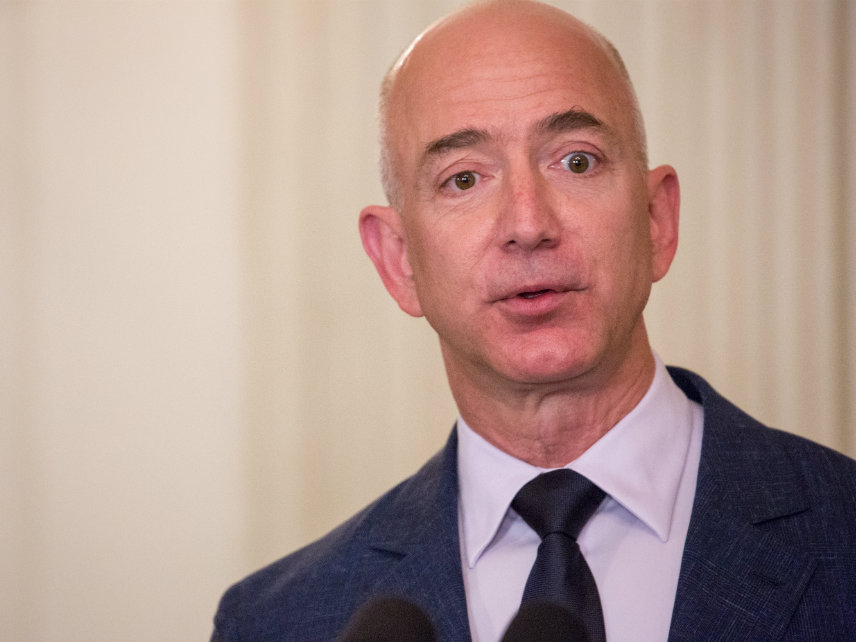 It's the sort of brazen move that might ordinarily trigger a front-page news story or an outraged editorial—a bunch of very rich individuals asking Congress to write them a law that would give them better negotiating power against other rich individuals.
It's the sort of brazen move that might ordinarily trigger a front-page news story or an outraged editorial—a bunch of very rich individuals asking Congress to write them a law that would give them better negotiating power against other rich individuals.
